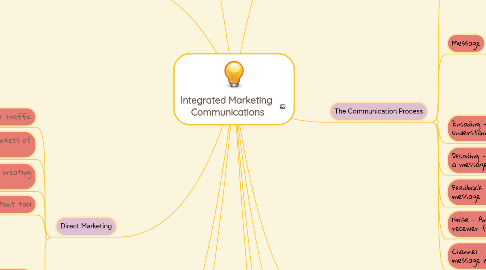
1. Objectives of Promotion
1.1. Provide information
1.2. Increase demand
1.3. Differentiate the product
1.4. Accentuate the product’s value
1.5. Stabilize sales
2. Elements of the Promotional Mix
2.1. Personal Selling
2.1.1. A seller’s promotional presentation conducted on a person-to-person basis with the buyer
2.2. Nonpersonal Selling
2.2.1. Advertising - Any paid, nonpersonal communication through various media about a business firm, not-for-profit organization, product, or idea by a sponsor identified in a message
2.2.2. Product placement - Marketer pays a motion picture or television program owner a fee to display his or her product prominently in the film or show
2.2.3. Sales promotion - Marketing activities that stimulate consumer purchasing and dealer effectiveness
2.2.4. Direct marketing - Use of direct communication to a consumer or business recipient designed to generate a response
2.2.5. Public relations - Firm’s communications and relationships with its various publics
2.2.6. Publicity - Nonpersonal stimulation of demand for a good, service, place, idea, person, or organization by unpaid placement of significant news regarding the product in a print or broadcast medium
2.2.7. Guerrilla marketing - Unconventional, innovative, and low-cost techniques to attract consumers’ attention
3. Direct Marketing
3.1. Helps increase store traffic
3.2. Opens new international markets of unprecedented size
3.3. Promotes goals beyond creating product awareness
3.4. Databases are an important tool
3.5. Direct Marketing Communication Channels
3.5.1. Direct mails such as brochures and catalogs
3.5.2. Telecommunications initiated by companies or customers
3.5.3. Television and radio through special offers, infomercials, or shopping channels
3.5.4. Internet via e-mail and electronic messaging
3.5.5. Print media such as newspapers and magazines
3.5.6. Specialized channels such as electronic kiosks
4. Pulling and Pushing Promotional Strategies
4.1. Pulling strategy - Promotional effort by the seller to stimulate final-user demand, which then exerts pressure on the distribution channel
4.2. Pushing strategy - Promotional effort by the seller directed to members of the marketing channel rather than final users
5. Measuring the Effectiveness of Promotion
5.1. Direct sales results test - Based on the specific impact on sales revenues for each dollar of promotional spending
5.2. Indirect evaluation - Concentrating on quantifiable indicators of effectiveness such as recall and readership
6. Definition
6.1. Marketing communications
6.1.1. Messages that deal with buyer-seller relationships
6.2. Integrated marketing communications (IMC)
6.2.1. Coordination of all promotional activities to produce a unified, customer- focused promotional message
6.2.2. IMC begins with their wants or needs and then works in reverse to the product, brand, or organization
6.2.3. Consumers receive many marketing messages all day
7. The Communication Process
7.1. Sender
7.1.1. Seeks to convey a message to the receiver
7.2. Message
7.2.1. Communication of information, advice, or a request by the sender to the receiver
7.2.2. The receiver decodes, or interprets, the message and sends feedback
7.2.3. Effective message does three things
7.2.3.1. Gains the receiver’s attention
7.2.3.2. Achieves understanding by both sender and receiver
7.2.3.3. Stimulates receiver’s needs and suggests appropriate means of satisfying them
7.2.4. AIDA - Steps through which an individual reaches a purchase decision: attention, interest, desire, and action
7.3. Encoding - Translating a message into understandable terms
7.4. Decoding - Receiver’s interpretation of a message
7.5. Feedback - Receiver’s response to a message
7.6. Noise - Any stimulus that distracts a receiver from receiving a message
7.7. Channel - Medium through which a message is delivered
8. Sponsorships
8.1. Organizations provide money or in-kind resources to an event or activity in exchange for a direct association with that event or activity
9. Developing an Optimal Promotional Mix
9.1. Nature of the Market
9.2. Stage in the Product Lifecycle
9.3. Price
10. Budgeting for Promotional Strategy
10.1. Promotional budgets may differ not only in amount but also in composition
10.2. percentage of sales method
10.2.1. The most common way of establishing promotional budgets
10.2.2. the percentage can be based on sales either from previous year or the current year
10.3. fixed-sum-per-unit method
10.3.1. It allocates a predetermined amount to each sales or production unit
10.4. meeting competition method
10.5. task objective method
10.5.1. Develops a promotional budget based on a sound evaluation of the firm's promotional objectives
11. The Value of Marketing Communications
11.1. Social Importance
11.1.1. What appeals to one group of consumers may seem tasteless to another
11.1.2. Ad agencies donate expertise for public service announcements that promote social causes
11.2. Business Importance
11.2.1. Long-term increase in funds allocated to promotion indicates faith in its ability to encourage attitude changes, brand loyalty, and additional sales
11.3. Economic Importance
11.3.1. Provides employment for millions of people

